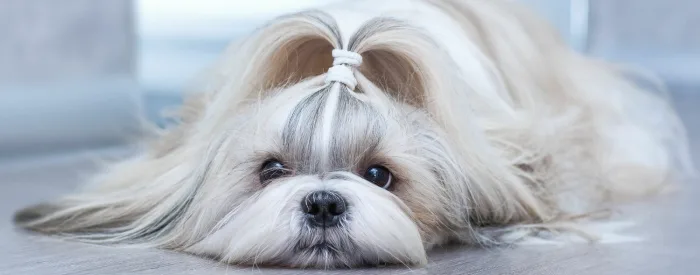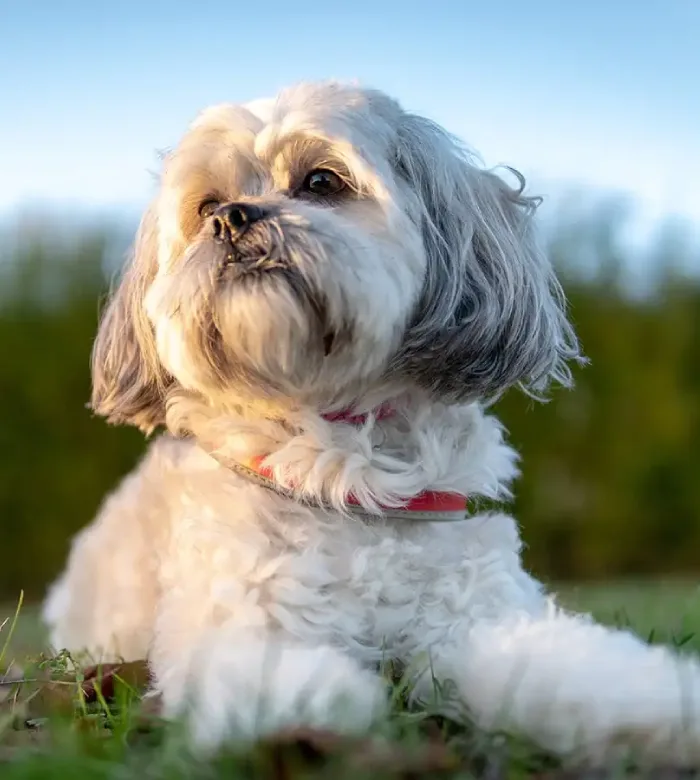Playful, Affectionate, Clever, Intelligent, Outgoing

We have 57 shih tzu puppies for sale in India. They are raised with love and care. Our puppies are friendly and make great family pets.
The price of a shih tzu in India changes based on location and breeder. But we offer good prices for our puppies.
Looking for a furry friend? Adopt one of our shih tzu puppies in India. We offer 24/7 pet support and many services across India.
Our puppies are health-certified, including KCI-certified. The love and companionship they bring are worth the price.
We offer top-quality Shih Tzu puppies. As shih tzu breeders, we focus on health, well-being, and socialization. Our goal is to create a safe space for our puppies to grow.
Looking for the perfect pet? Come find shih tzu puppies that match your lifestyle. Whether you're searching for shih tzu puppies near me or want to buy shih tzu puppies, we're here to assist.
Our breeders love the Shih Tzu breed and aim for excellence. We choose our parent dogs for their great temperament and looks. This ensures our puppies are healthy, friendly, and cute.
Our parent dogs are award-winners with outstanding qualities. We're proud to show their achievements. Meeting them will help you understand our breeding program and puppy quality.
We promise top service and support to our customers. From the first contact to adoption, we aim for a smooth experience. Our goal is to help you find a Shih Tzu puppy that brings joy and companionship.

| Puppy Age | Price Range | Quality |
|---|---|---|
| 8-12 weeks | ₹20,000 - ₹30,000 | Pet-quality |
| 3-6 months | ₹30,000 - ₹50,000 | Show-quality |
| 6-12 months | ₹40,000 - ₹90,000 | Champion-bloodline |
We are excited to share the joy of Shih Tzu puppies with families in India. Shih Tzu dogs are loyal and loving, making them great family pets. Their friendly nature is why Shih Tzu puppies are so popular.
The shih tzu dog is a beloved friend. Their price varies based on location and the breeder's reputation. In India, the shih tzu breed price can be from ₹25,000 to ₹90,000 or more. Remember, owning a Shih Tzu also means monthly costs for food, grooming, and healthcare.
Here are some estimated costs for a Shih Tzu puppy:
Many families say the joy of a Shih Tzu puppy is worth the cost. With the right care, Shih Tzus can live 10 to 16 years. They bring love and affection to their families for many years.
Shih Tzu puppies are great for families. They are friendly and outgoing. This makes them perfect for homes with kids and other pets. Shih Tzus are loved by many families.
Thinking about shih tzu puppies for adoption? Remember, the cost varies. It depends on where you are, the breeder, and the puppy's bloodline. But, with the right care, akc shih tzu puppies can bring lots of joy and love.
Shih Tzus are gentle and patient. This makes them great for families with kids. They need some exercise and daily brushing to keep their coat nice.
Shih Tzus fit well in many homes. They do well in apartments or houses with yards. They are quiet and don't shed much, making them perfect for small spaces.
Shih Tzus are very social. They get along well with kids and other pets. They love to be close to their owners, earning them the nickname "velcro dogs."
We are excited to share that we have adorable Shih Tzu puppies for sale in India. Our litter includes puppies in various coat colors and patterns. You can find solid whites, blacks, and even parti-colors and brindles. We're sure you'll find a puppy that will win your heart.
We are proud to be reputable shih tzu breeders in India. Our puppies are healthy and well-socialized. They are raised with love and care. If you're looking for a shih tzu puppy in India, contact us to learn more and schedule a meeting.
Our current litter includes the following puppies:
To reserve a puppy, please contact us to discuss the details. A deposit is needed to secure your spot. The rest is due when you pick up your puppy. We accept many payment methods and offer financing to help you bring your new friend home.
| Puppy Name | Price | Coat Color |
|---|---|---|
| Jam | ₹30,000 | White |
| Tesla | ₹27,000 | Black |
| Oreo | ₹30,500 | Parti-color |
We care a lot about the health of our Shih Tzu puppies. We offer shih tzu health guarantees and shih tzu documentation. This makes sure we are open and honest with our customers.
Our health guarantee lasts for one year. It covers problems that start at birth or are passed down in families. If you add NuVet vitamins, it can last two years.
Our shih tzu health guarantees also cover big problems like organ failure. But, this only applies to genetic diseases. Patellas that slip out of place need to be very bad, Grade 3 or higher, to be covered.
We need a notarized vet report to confirm any hereditary diseases. And, if a puppy dies from a covered condition, we need a full autopsy.
Here are the main points of our shih tzu health guarantees and shih tzu documentation:
We think our shih tzu health guarantees and shih tzu documentation give our customers peace of mind. They know they are getting a healthy and well-socialized puppy. If you want to know more, please contact us.
At Pawsypoo, we know getting a new puppy can be tough, even for first-timers. That's why we offer a full shih tzu care package. It has everything you need to start off right. This package is key to our promise of shih tzu puppy care.
Our care package includes vet checks, vaccinations, and basic needs like food, toys, and a bed. We want every puppy to have the best start. We're here to support you in making your puppy's life happy and healthy.
Here's what our shih tzu care package includes:
Our shih tzu care package helps you give your puppy a great start. And with our focus on shih tzu puppy care, you can be sure you're getting a healthy, happy puppy from a trusted breeder.
| Component | Description |
|---|---|
| Initial Veterinary Checks | Ensure your puppy is healthy and thriving |
| Vaccination Schedules | Protect your puppy from serious diseases |
| Essential Supplies | Get you started with food, toys, and bedding |
Thinking about getting a Shih Tzu puppy? It's key to know what affects the shih tzu price in india. Prices can change a lot based on where you are, the breeder's reputation, and the puppy's bloodline. Our family aims to be clear and honest about our shih tzu puppies for sale in india prices.
Shih Tzu puppies in India can cost between ₹25,000 to ₹60,000. Prices vary by city:
Several things can raise the price of Shih Tzu puppies. These include the puppy's bloodline, the breeder's reputation, and where you are. Puppies from champion lines or with KCI certification cost more. Also, puppies are pricier than adult dogs.
We know buying a Shih Tzu puppy is a big deal. That's why we have flexible payment plans. We want to give you great value and make sure our puppies are healthy and happy.
Welcoming a new Shih Tzu puppy into our family is exciting. Shih Tzu puppy preparation is key for a smooth transition. Preparing your home early is important. It makes a safe and comfy space for your new pet.
Shih tzu puppy proofing is a must. Secure loose wires, toxic stuff, and breakable items. Create a safe area, like a crate or puppy-proofed room. This is where your puppy can play and relax without worry.
Here's what you need for shih tzu puppy preparation:
Follow these tips to make a safe and comfy home for your Shih Tzu puppy. Always focus on shih tzu puppy proofing and preparation. This ensures a smooth start for both you and your puppy.
| Item | Description | Cost |
|---|---|---|
| Food and water bowls | Stainless steel or ceramic bowls | ₹500 - ₹1000 |
| Comfortable bed or crate | Orthopedic bed or crate with soft bedding | ₹2000 - ₹5000 |
| Toys and chews | Variety of toys and chews, like plush toys and rubber chews | ₹1000 - ₹3000 |
We're excited to help you find the perfect Shih Tzu companion. Our puppies in India are born to bring joy and laughter. They have loving personalities and adapt well to any home.
Our breeding facility focuses on top care and responsible breeding. Each puppy gets great vet care, socialization, and a care package. We want every Shih Tzu to find a loving family.
Looking for a playful or affectionate pet? Our Shih Tzu puppies will capture your heart. Contact us today to learn about our puppies and welcome a new furry friend home.
Shih Tzu puppies are friendly and outgoing. They make great family pets. They adapt well to different homes and are easy to care for.
To make the transition smooth, puppy-proof your home. Create a safe and comfy space for your puppy. Don't forget to get food, toys, and bedding.
We offer health guarantees and documents for our puppies. This includes vaccination records and health clearances. We are open and honest about our puppies' health.
Shih Tzu puppy prices in India vary. This depends on location, breeder, and bloodline. We have payment plans to fit your budget and offer great value.
Our care package includes vet checks and vaccinations. It also has food, toys, and bedding. We want your puppy to have the best start in life.
Booking a puppy is easy. Just contact us to learn about our puppies. Then, schedule a meeting to see them in person.